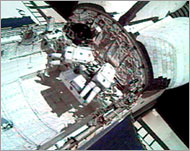Discovery begins its return to Earth
Discovery has undocked from the International Space Station taking a first step on its dangerous return to Earth.

With pilot Jim Kelly at the controls, Discovery smoothly unlatched from the docking port on Saturday and slowly separated from the station to which it has been linked since 28 July in the first shuttle mission to the space outpost in more than two and a half years.
Before leaving the area, Discovery was to fly around the station once while astronauts snapped photos of its exterior for inspection by Nasa engineers on Earth.
Later on Saturday, the Discovery crew was to check out the shuttle’s steering rockets and start stowing gear in preparation for landing at Kennedy Space Centre in Florida on
Monday.
Discovery was the first shuttle to visit the space station since Endeavour made the trip in November 2002 and the first to fly since the Columbia disaster on 1 February 2003.
While at the station 352km above Earth, Discovery astronauts, Soichi Noguchi and Steve Robinson, conducted three spacewalks, which were mostly devoted to maintenance work on the station and installing a storage platform on its exterior.
The third walk included an unprecedented repair by Robinson on the shuttle’s belly as he plucked out two cloth strips protruding from the heat shield.
Goods ferried
Discovery transferred tonnes of cargo to and from the space station, leaving it well stocked with food, water and other supplies and with far less trash and unneeded equipment that had piled up since the last shuttle visit.
 |
|
Tonnes of cargo were transferred |
Shuttles are supposed to be primary suppliers for the station, but Russian spacecraft have ferried in goods since the Columbia disaster in 2003.
Space station astronauts Sergei Krikalev and John Phillips warmly thanked the Discovery crew on Friday for their visit and sent them off with handshakes and hugs.
“We want to say thank you, all of you,” Krikalev said. “We are waiting for this flight for very long years, more than two years already.”
Columbia disaster
The Columbia disaster occurred because a 0.76kg piece of insulating foam from the external fuel tank struck the shuttle at launch and punched a hole in its wing heat shield.
Sixteen days later, as Columbia glided towards landing, superheated gases generated by re-entry penetrated the wing and broke the shuttle apart. The seven astronauts on board died.
Videos at Discovery’s launch showed tank foam breaking loose from its fuel tank, which dismayed Nasa after it spent two and a half years and $1 billion on safety upgrades to the shuttle fleet.
The agency said it would not fly a shuttle again until the foam problem is fixed.
Nasa officials, however, said on Friday they hoped they could launch again as early as 22 September.